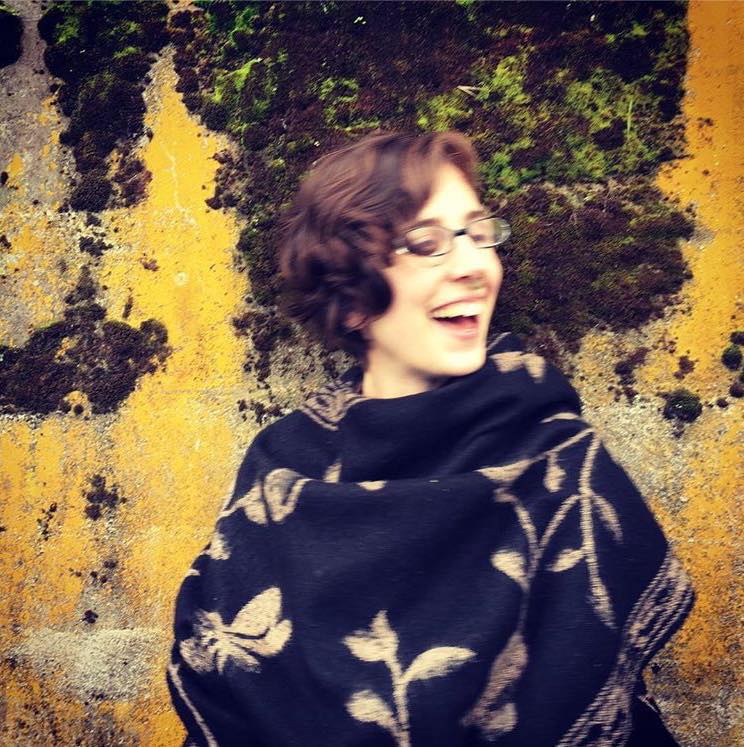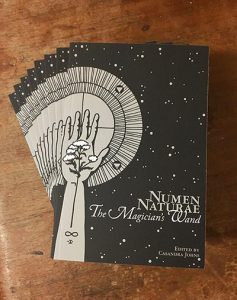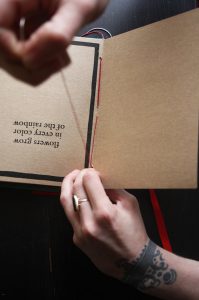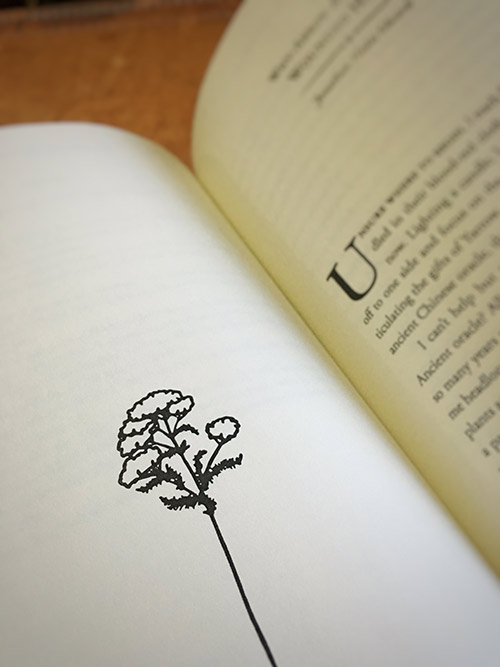Talking plants and publishing with Casandra Johns
Casandra Johns, a dynamic editor, publisher, herbalist, print artist extraordinaire is joining the Revelore editorial team. Johns, of Oregon, is the creator of House of Hands, her own press and book arts operation, which has a few titles to its credit and a series of handbound books. She took some time out of her busy schedule to talk with our founder Jenn Zahrt about how she got into publishing, what she’s up to at House of Hands, and where she sees herself going!

JZ: Casandra! Thanks for taking the time to share your world with me. I know you have a background in herbalism. I’m curious as to how you landed in the world of publishing?
CJ: About four years ago I had the privilege of participating in a weekly meditation group with Scott Kloos in Portland, Oregon. Scott is a dear friend and teacher. His group was focused on building relationships and ceremony around our connection with the plants of Cascadia. Each week we would all take a tincture of a plant and sit with it in silence or song for about three hours. We would work with a single plant for a long period of time—I think we worked with Saint John’s Wort for the better part of three months. I was in a clinical herbal program at the time and just beginning to delve into occult studies as well as Gnosticism and Jungian psychology. All of those things really informed my process with the plants during our groups’ meditations.
JZ: How did you come up with the idea for Numen Naturae, the series of books you launched last year, which over time will cover one plant species and its relationship to one tarot card?
CJ: I know people who see visions and have very real conversations with plants. For me it is (usually) more of a process of active imagination, though I do consider myself an animist. In these meditations, the plants sort of began to connect the dots. I think the first instance where this struck me in a really powerful way was a meditation with Devil’s Club. People associate this plant with boundaries, but it felt much more complex to me, much richer and somehow also linked to the idea of destruction, like a phoenix bursting into flame before it is born anew. I suddenly saw in my mind’s eye an image of the Tower card, trump 16 of the tarot. It was the perfect analogy for everything that I experienced to be the psychological process supported by Devil’s Club. After that I began to work with the imagery of the tarot cards more in my meditations. As someone who has Mercury in Pisces, I really struggle with words sometimes. My experience is often that words just fail to do the trick, they fall flat, or they go too far in defining something so that the inchoate essence of the thing is actually lost in the process. I think that’s why playing with these rich archetypal images of the tarot really “worked” for me. However, I felt as if I was experiencing these things in a bit of a vacuum.
As I began to share my experiences with folks in the community, I realized that others noticed similar connections between the plants and certain images or archetypes, but I couldn’t find anything in the literature talking about it. Really, I think that Numen Naturae exists because I needed to create the book that I so desperately wanted to read.
There is this tendency in herbal publications to talk about plants in fairly reductionistic ways. There are science-oriented texts catering toward allopathy in an effort toward legitimacy. There are texts on more traditional energetic models which are still very physiological in their focus, and there are also texts that are focused on plant magic in the kitchen witch tradition. With a few exceptions, that’s really the sum of the literature available.
Very few people are talking about the personhood of plants and the ways they impact us emotionally, psychologically, and spiritually in any sort of refined or public way. I’ve been lucky to have teachers like Scott Kloos, Matthew Wood, and Sean Donahue (I would add Stephen Harrod Buhner’s books to this list) who do bring that piece into their teaching, but I wanted to create a platform where this way of relating to the plants could be the focal point. (Interestingly, as I was in the process of conceiving this project, you published the first volume of Verdant Gnosis, so that was really validating for me.)
In the esoteric world, there are also very few people talking about incorporating plants into the work. Most often I see the herbs incorporated in talismanic magic, and alchemical texts will of course go into their deeper symbolism at times, but still that element of relationship seems to be largely absent. Daniel Schulke’s work is the main exception that I have encountered. As much as I admire it, his perspective can feel inaccessible at times, shrouded in mysticism and occult. Perhaps that is part of its charm.
Numen Naturae is really an effort on my part to begin a dialogue. To occultists I would ask: How can we incorporate plants into our magical praxis and what type of relationship with the plants is necessary in order to do that work? To herbalists: Who are these plants that we are dosing our clients with? Do we really know them? If our practice is truly holistic, should we not explore how these beings interact with us on levels other that the physical? Herbalists will ask those questions at times, but it is mostly relegated to the realm of flower essences and spiritual healing at this point. My premise is that we can explore these plants and whole beings and the ways that they impact humans as whole beings.
This first volume of Numen Naturae only just begins to broach the scope of this subject. I also feel like there is something much larger here than “how to do plant magic,” or “how to treat a client holistically,” and that is why I have a lot of admiration for the Verdant Gnosis books and the Viridis Genii Symposium. These plants are allies. They have their own innate personhood and have evolved alongside humanity, had an impact on our cultures, our myths, our ability to sustain ourselves, heal ourselves, and I want to know more about those relationships. I want to know how other people experience and work with these spirits, what stories and history and images they receive. I want to know more about Devil’s Club than a list of chemical constituents and the one-sentence label on a flower essence bottle telling me that it “helps with psychic boundaries.” There is just so much more there and it affects us on a deep spiritual and psychological level.
 As a clinician, I never want to give someone plant medicine again without having a personal relationship with that plant and understanding the deeper impact it will have on a client. I want to treat it as if I am introducing clients to a dear old friend who happens to have these amazing superpowers and can guide them through a process of healing their entire Self. And again, this first volume is really just scratching the surface. It’s about a cultural shift in the way we (herbalists, occultists, whomever) interact with these spirits and I am excited to see that process unfold, even if it takes decades.
As a clinician, I never want to give someone plant medicine again without having a personal relationship with that plant and understanding the deeper impact it will have on a client. I want to treat it as if I am introducing clients to a dear old friend who happens to have these amazing superpowers and can guide them through a process of healing their entire Self. And again, this first volume is really just scratching the surface. It’s about a cultural shift in the way we (herbalists, occultists, whomever) interact with these spirits and I am excited to see that process unfold, even if it takes decades.
JZ: That’s quite a genesis story. Your first volume definitely captures that spirit of relationship. It’s such a simple yet powerful idea: distill the focus to two areas and see what can be built up from it. And you have built up a company around it!
CJ: Exactly. House of Hands really exists because Numen Naturae needed to exist. I’ve always been obsessed with books and art, with the art of the book. My childhood fantasy was to grow up and be a monk so that I could illuminate manuscripts in a monastery. Being neither Catholic nor male, and living in a post-Gutenberg world, I realized at some points that I needed other opinions.
JZ: Don’t we all!
CJ: Ha! Yes, but really, House of Hands came into being out of necessity. A few years ago I was a single mom in the process of exiting a really abusive relationship and watching my life fall to pieces. It was like watching my worst fears come true. I knew that I needed to do something that I loved or I would lose my sense of self, so I got back into block printing and bookbinding. I created Watch Them Grow, a hand-bound children’s herbal filled with block prints and seed packets. Having a project was essential for me at the time. I had such success with it that I thought, “well, maybe I can do more.” After a halting attempt at designing a book with friend, I decided to try one on my own. I solicited essays from some friends, got a small business grant to buy myself a computer with the design software that I needed, and set about learning how to edit a book, how to use the software, learning about typography and grids and Renaissance margins and all of the other details that I had no idea I would encounter. It was quite an undertaking, but I loved the process. The most difficult part has probably been knowing that this is my first time attempt, so I will likely look back years from now and blush a little at all of my beginner’s errors. But such is life! I’m loving it.
 JZ: That is so awesome that you were able to generate this momentum out of adversity and really step into your creativity and power. Given that you have had to learn a lot of tough lessons along the way, what advice would you give to someone who is thinking about starting out?
JZ: That is so awesome that you were able to generate this momentum out of adversity and really step into your creativity and power. Given that you have had to learn a lot of tough lessons along the way, what advice would you give to someone who is thinking about starting out?
CJ: To someone just starting out I would say: don’t do it unless you love it and never scoff at advice or support. It takes so many hands and minds and eyes to make things like this happen, and getting over my own hubris has been an ongoing struggle. None of us want to need help! Asking for help has been difficult and important, and being willing to showcase my beginner’s mistakes has really been an exercise in humility. Luckily 95% of my feedback has been helpful and compassionate, and I am so grateful for that.
JZ: Asking for help can be seriously challenging. For sure. What has been your favorite part of creating House of Hands from scratch?
CJ: My favorite part of creating this from scratch has been (oh boy, this is revealing) having total control. It’s also the most terrifying part, as it happens. I love taking a collection of ideas, images, writings, whatever, and sorting through it, recreating it, molding it into something beautiful which is more profound than merely the sum of its parts. I don’t consider myself a very original thinker, but putting existing pieces together in a pleasing way brings me great joy. I get to do that as an editor, a designer, and I get to do that when I build my website and take product photos and illustrate, and it is just so wonderful.
JZ: That’s great. I can totally see the joy that House of Hands brings you through what you are making with it. What will your next publication be?
CJ: My next publication is going to be volume 2 of Numen Naturae, and I announced the call for papers for Volume 3 two days ago. The first volume focuses of Yarrow as it relates to the archetype of the Magician. Volume 2 will be about Devil’s Club and the Tower, and Volume 3 will be about Black Cohosh and the Priestess. For Volume Two, the Devil’s Club and Tower feel fitting, considering the correlations between that image and the Tower of Babel, and given everything happening right now in terms of the political climate, the actual climate, and social justice. I want to dive into that process of death and rebirth because of the cultural implications, but also because I feel like I am just now coming out of that place on a personal level and have a lot to say on the subject.
JZ: What other kinds of publications can we expect from you and House of Hands?
CJ: For the future, I am entertaining a project based on a talk that I gave last year at the Portland Plant Medicine Gathering about the language of Western Energetics. I studied linguistics before dropping out of school, and (again with the Mercury in Pisces thing) the subject really fascinates me. The way we talk about things shapes the way we think about them in such a profound way (I see this discussion a lot lately in the realms of identity politics). This project would be more clinical in nature, but I want to bring awareness to how we talk about the plants and how that has an impact on our relationship to them and our relationship to clients as an extension. I am also toying with redesigning and publishing some seventeenth-century herbals which are pretty difficult to find these days, and beginning collaborations with a few other herbalists whose names I will save for a later surprise. There are other aspects to House of Hands that I would also like to spend more time with, like printmaking and bookbinding, but publication is the primary focus at this moment.
JZ: We are also excited to have you on the Revelore team, contributing your many talents in the book arts world. Do you see any trends forming in your work, things that make you different, make you stand out?
CJ: I’m excited to collaborate with Revelore as well! I can’t wait to see what we come up with. I think that the main point of unity I see within my own projects is that the plants are the focal point first and always. That’s not to say that a press with another focus shouldn’t publish books about plants, but I really want to stay true to this idea of initiating conversations about/with these plants with the intention of facilitating ways that the herbs themselves can have bigger voices. They don’t speak the same way we do and our culture is so obsessed with language, I think that they want some human friends with metaphorical megaphones.
JZ: That is so beautiful, and definitely one of the things I admire about your work and vision. You are putting your Pisces Mercury to very good use. One last question before I let you go… Where do you see yourself in five to ten years?
CJ: One of the things that I learned from having a child is that I have to plan ahead meticulously and then sit back and watch moment by moment as all of the planning unfolds in an entirely different way than expected. I would love to do this full-time in the future. At the moment I am a full-time mom and about to be a full-time student as well. It has been a lot of hard work, and I’m sure that will continue, but I would like to be able to look back ten of fifteen years from now and see House of Hands as something that has supported my family, created relationships, given people in my community a venue to share their voices, and honored my relationship with these plants.
JZ: I hope that for you as well! Thanks so much for sharing your time, energy, and story with me.

~
If you feel called to join her Numen Naturae project, the call for papers for Volume 3 can be found here, and you can find the rest of Casandra’s work at her website www.houseofhands.net and look out for her magical touch on future Revelore publications!
- Welcoming Jeremy Johnson to Revelore - 2017-08-09
- Talking plants and publishing with Casandra Johns - 2017-08-04
